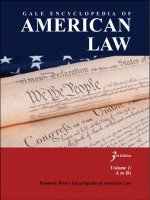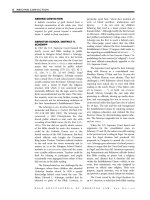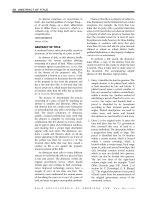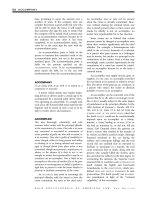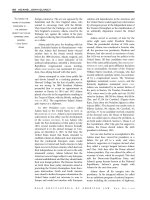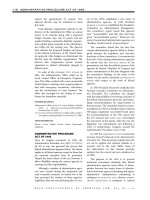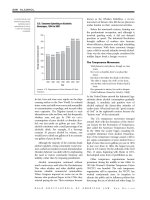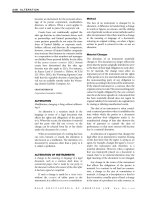Gale Encyclopedia Of American Law 3Rd Edition Volume 2 P6 pps
Bạn đang xem bản rút gọn của tài liệu. Xem và tải ngay bản đầy đủ của tài liệu tại đây (608.32 KB, 10 trang )
Binney wrote several biographies and case
reports, including Leaders of the Old Bar of
Philadelphia (1859). He died August 12, 1875,
in Philadelphia.
v
BIRD, ROSE ELIZABETH
Rose Elizabeth Bird served as the first woman
on the California Supreme Court, becoming the
chief justice of one of the most prominent
appellate courts in the United States. Bird became
a controversial figure during the 1980s, as her
adamant opposition to
CAPITAL PUNISHMENT drew
fire from political conservatives. In 1986 these
views led voters to remove her from office. In her
nine years on the court, however, Bird led a
liberal majority that strengthened environmental
laws, consumer rights, and women’srights.
Bird was born on November 2, 1936, in
Tucson, Arizona. She spent her childhood in
Arizona and New York, where she graduated
from Long Island University in 1958. She
attended graduate school in political science at
the University of California at Berkeley in 1960
but switched her career path to law when she
entered Berkeley’s Boalt Hall School of Law
in 1962. After graduation in 1965, Bird was
admitted to the
PRACTICE OF LAW in California.
Following graduation, Bird served a one-year
term as a law clerk for the chief justice of the
Nevada Supreme Court. In 1966 she joined the
Santa Clara County, Californ ia, public defenders
office. Bird remained in the public defenders
office until 1974, serving successively as deputy
PUBLIC DEFENDER, senior trial deputy, and chief
public defender of the appellate division. As head
of the appellate division, Bird oversaw all public
defender criminal appeals to the California
Courts of Appeal and the California Supreme
Court. In addition to these duties, Bird served as
an adjunct professor oflaw at Stanford University
Law School from 1972 to 1974.
Bird’s eventual rise to the California Supreme
Court began when she became the chauffeur
during Democrat Jerry Brown’s campaign for the
governorship in 1974. Following his election,
Brown appointed Bird to his cabinet as secretary
of agriculture. She spent most of her time in that
office working to settle a series of ongoing
disputes between growers and farm unions.
Moreover, she drafted reforms to the state’s
farm
LABOR LAW and to consumer legislation.
In 1977, after twenty-two months in the
cabinet, Governor Brown appointed Bird, then
age 40, as chief justice of the California Supreme
Court. She gained immediate national promi-
nence because she was the first woman to serve
on the state’s high court. As a member of a
liberal majority, Bird established herself as a
brilliant and combative judge. During her
tenure, the court issued decisions that promoted
environmental regulation and
CIVIL RIGHTS for
racial minorities and women. Other decisions
gave tenants more rights and poor women the
right to have a state-funded
ABORTION.
Coming from the public defenders office, the
large corporate law firms and influential bar
associations viewed her as an outsider. Bird
signaled her disdain for the “old boys” system of
privilege by selling the chief justice’s Cadillac
and by staying at inexpensive motels rather than
at expensive hotels while on state business.
She also exercised strong leadership over the
administration of the courts. Bird promoted racial
and gender diversity on the bench. During her
tenure, more than 1,000 judges were appointed
who were either persons of color or female. In
Horace Binney 1780–1875
❖
◆◆
◆
◆
◆
1775–1783
American
Revolution
1780 Born,
Philadelphia, Pa.
1800 Admitted to
Philadelphia bar
1806 Elected to
Pennsylvania legislature
1816–19 Served on
the Philadelphia
Select Council
1810–16 Served on
the Philadelphia
Common Council
1808 Became director of the
First Bank of the United States
1833–35 Served
in the U.S.
House of
Representatives
1844 Won
the Girard
Trust case
1859 Leaders of
the Old Bar of
Philadelphia
published
1861–65
U.S. Civil
War
1875 Died,
Philadelphia,
Pa.
▼▼
▼▼
17751775
18251825
18501850
18751875
19001900
18001800
❖
GALE ENCYCLOPEDIA OF AMERICAN LAW, 3RD E DITION
38 BIRD, ROSE ELIZABETH
addition, she led the court system to change its
rules to allow cameras in the courtroom. Finally,
she initiated a study of gender bias in the courts, a
groundbreaking effort that was adopted by many
other state courts during the 1980s and 1990s.
It was Bird’s opposition to the death
penalty, however, that had the greatest effect
on her judicial career. California reinstated the
death penalty in 1977 over the veto of Governor
Brown. Thus, Bird took the bench at the same
time that death penalty appeals would return to
the state supreme court. Although Bird never
discussed her personal views while on the court,
she voted to overturn all 64 death sentences
under her considerati on.
By the mid-1980s, conservative political
leaders began attacking Bird and members of
the liberal majority who regularly voted against
the death sentence. In 1986 Republican Gover-
nor George Deukmejian, along with local
prosecutors, led a hard-hitting campaign to
remove Bird and fellow justices Cruz Reynoso
and Joseph Grodin from the court. They
became the first judges in state history to be
removed from office in a retention election.
A retention election allows citizens to vote to
retain or oust the judge in which there are no
opposing candidates. Governor Deukmejian then
appointed three justices to fill the vacancies.
Following her defeat, Bird dropped from the
public scene. She volunteered at a Palo Alto
LEGAL AID office, doing clerical work because she
let her bar registration dues lapse. She also
worked at a local food bank, taught for a short
time in Australia at the University of Sydney,
and lectured occasionally around the country.
She died on December 4, 1999, in Palo Alto
from complications related to breast cancer.
FURTHER READINGS
Beck, Susan. 1998. “Justice on the Run.” American Lawyer
(September) 76.
Cooper, Claire. 2000. “Rose Bird: The Last Interview.”
California Lawyer 20 (February).
Purdum, Todd S. “Rose Bird, Once California’s Chief Justice,
Is Dead at 63.” The New York Times (November 6, 1999).
BIRTH CONTROL
Birth control is a measure or measures under-
taken to control the number of children born by
preventing concepti on and reproduction.
Rose Bird.
AP IMAGES
Rose Elizabeth Bird 1936–1999
❖
❖
1936 Born,
Tucson,
Ariz.
1939–45
World War II
1961–73
Vietnam War
1965 Graduated from Boalt Hall
School of Law, University of
California, Berkeley
1966–74 Served as first woman deputy public defender in Santa Clara County, Cal.
1972–74
Taught at
Stanford
Law
School
◆
1975 Appointed secretary of agriculture, first woman cabinet member in California state history
1977–87 Served
as first woman
chief justice of
the California
Supreme
Court and chair
of Judicial Council
of California
◆
1986 Ousted from court, along with two colleagues, in historic retention election; left court in January 1987
◆
1991 Became
full-time
volunteer in
East Palo Alto
Community
Law Clinic
1997 Received Conscience Award from American Civil Liberties Union of Southern California
▼▼
▼▼
19001900
19501950
19751975
20002000
19251925
◆
1999 Died,
Stanford,
Cal.
◆
2000 California
Public Defenders
Association
inaugurated the
Rose Elizabeth
Bird Award
◆
◆
1987 Established the Committee on Gender Bias in the Courts
GALE ENCYCLOPEDIA OF AMERICAN LAW, 3RD E DITION
BIRTH CONTROL 39
In the 1800s, temperance unions and anti-
vice societies headed efforts to prohibit birth
control in the United States. Anthony Com-
stock, the secretary of the Society for the
Suppression of Vice, advocated a highly influ-
ential law passed by Congress in 1873. It was
titled the Act for the Suppression of Trade in,
and Circulation of Obscene Literature and
Articles of Immoral Use, but known popularly
as the Comstock Law or Comstock Act (18 U.S.
C.A. § 1416-62 [1964]; 19 U.S.C.A. § 1305
[1964]). The Comstock Act prohibited the
use of the mail system to transmit obscene
materials or articles addressing or for use in
the prevention of conception, including infor-
mation on birth control methods or birth
control devices as well as birth control devices
themselves.
Soon after the federal government passed
the Comstock Act, more than half of the states
passed similar laws. All but two of the remaining
states already had laws banning the sale, dis-
tribution, or advertising of contraceptives. Con-
necticut had a law that prohibited even the use
of contraceptives; it was passed with little or
no consideration for its enforceability.
Despite popular opposition, birth control had
its advocates, including
MARGARET SANGER.In1916
Sanger opened in New York City the first birth
control clinic in the United States. For doing so,
she and her sister Ethel Byrne, who worked with
her, were prosecuted under the state’sversionof
the Comstock law (People v. Byrne, 99 Misc. 1, 163
N.Y.S. 682 [1917]; People v. Sanger, 179 A.D. 939,
166 N.Y.S. 1107 [1917]). Both were convicted and
sentenced to thirty days in a workhouse.
After serving her sentence, Sanger continued
to attack the Comstock Act. She established the
National Committee for Federal Legislation for
Birth Control, headquartered in Washington,
D.C., and proposed the doctor’sbill.This bill
advocated change in the government’spolicy
toward birth control, citing the numerous
instances in which women had died owing to
illegal abortions and unwanted pregnancies. The
bill was defeated, due, in part, to opposition from
the Catholic Church and other religious groups.
But when the issue of Sanger’s sending birth
control devices through the mail to a doctor was
pressed in United States v. One Package (13 F.
Supp. 334 [S.D.N.Y. 1936]), the court ruled that
the Comstock Act was not concerned with
preventing distribution of items that might save
the life or promote the well-being of a doctor’s
patients. Sanger had sought to challenge the
Comstock Act by breaking it and sending
contraception in the mail. Her efforts were
victorious and the exception was made. The
doctor to whom Sanger had sent the device was
granted its possession.
Sanger furthered her role in reforming
attitudes toward birth control by founding the
Planned Parenthood Federation of America in
1942. Planned Parenthood merged previously
existing birth control federations and promoted
a range of birth control options. In the 1950s,
Sanger supported the work of Dr. Gregory
Pincus, whose research eventually produced the
revolutionary birth control pill.
The birth control pill
is one of the most
widely used forms of
birth control. In the
1950s, birth control
advocate Margaret
Sanger raised
$150,000 to pay for
research into the
development of the
birth control pill by
Dr. Gregory Pincus.
AP IMAGES
GALE ENCYCLOPEDIA OF AMERICAN LAW, 3
RD E DITION
40 BIRTH CONTROL
CONTRACEPTIVE USE BY WOMEN OF CHILDBEARING AGE, 15 TO 44 YEARS OLD, IN 2002
SOURCE: Centers for Disease Control and Prevention, National Center for Health Statistics, Vital and Health Statistics,
series 23, no. 25, December 2005.
a
Numbers may not add up to 100 due to rounding.
b
Includes sterilizations performed on women for contraceptive or medical reasons, as well as sterilizations performed on husbands
or partners.
c
Includes IUD, diaphragm, withdrawal, and other methods.
d
Includes women who have never had intercourse.
All women age 15–44
a
Periodic abstinence (includes natural family planning) 0.9%
Implant, patch, or injectable 4.1%
Condom 11.1%
Oral
contraceptive
19.0%
Other nonsurgical contraceptives
c
4.6%
Surgically
sterile
b
22.4%
Not using
contraceptives
d
38.1%
Other nonsurgical contraceptives
c
3.3%
Implant, patch, or injectable 1.3%
Age 40–44
a
Periodic abstinence (includes natural family planning) 1.6%
Condom 8.0%
Oral contraceptive 7.6%
Surgically
sterile
b
47.4%
Not using
contraceptives
d
31.0%
Implant, patch, or injectable 4.8%
Age 15–19
a
Periodic abstinence
(includes natural family planning) 0.0%
Other nonsurgical contraceptives
c
1.5%
Condom 8.5%
Surgically sterile
b
0.0%
Oral
contraceptive
16.7%
Not using
contraceptives
d
68.5%
Birth Control
Implant, patch, or injectable 7.0%
Age 20–24
a
Periodic abstinence (includes natural family planning) 0.8%
Other nonsurgical contraceptives
c
4.5%
Condom
14.0%
Oral
contraceptive
31.8%
Surgically sterile
b
2.7%
Not using
contraceptives
d
39.4%
ILLUSTRATION BY GGS
CREATIVE RESOURCES.
REPRODUCED BY
PERMISSION OF GALE,
A PART OF CENGAGE
LEARNING.
GALE ENCYCLOPEDIA OF AMERICAN LAW, 3
RD E DITION
BIRTH CONTROL 41
By the 1960s, partly as a result of Sanger’s
efforts, popular and legal attitudes toward birth
control began to change. The case of Griswold v.
Connecticut (381 U.S. 479, 85 S. Ct. 1678, 14 L.
Ed. 2d 510 [1965]), loosened the restrictions of
the Comstock Act. When the Planned Parent-
hood League of Connecticut opened in 1961,
its executive director, Estelle Griswold, faced
charges of violating Connecticut’s ban on the
use of contraceptives (Conn. Gen. Stat. Ann. §§
53-32, 54-196 [1958]).
A divided Supreme Court overturned
Griswold’s conviction with a ground-breaking
opinion that established a constitutional right
to marital privacy. The Court threw out the
underlying Connecticut statute, which prohib-
ited both using contraception and assisting or
counseling others in its use. The majority
opinion, authored by Justice
WILLIAM O. DOUGLAS,
looked briefly at a series of prior cases in which
the Court had found rights not specifically
enumerated in the Constitution—for example,
the right of freedom of association, which the
Court has said is protected by the
FIRST
AMENDMENT
, even though that phrase is not used
there (NAACP v. Alabama, 357U.S.449,78S.
Ct. 1163, 2 L. Ed. 2d 1488 [1958]). Douglas
concluded that various guarantees contained in
the Bill of Rights’ Amendments One, Three,
Four, Five, Nine, along with Amendment
Fourteen, create “zones of privacy,” which
include a right of marital privacy. The Connecti-
cut statute, which could allow police officers to
search a marital bedroom for evidence of
contraception, was held unconstitutional; the
government did not have a right to make such
intrusions into the marital relationship.
The other branches of the government
followed the Court’s lead. President
LYNDON B .
JOHNSON endorsed public funding for family
planning services in 1966, and the federal govern-
ment began to subsidize birth control services for
low-income families. In 1970 President
RICHARD M.
NIXON signed the Family Planning Services and
Population Research Act (42 U.S.C.A. § 201
et seq.). This act supported activities related to
population research and family planning.
More and more, the Comstock Act came to
be seen as part of a former era, until, in 1971,
the essential co mponents of it were repealed.
But this repeal was not necessarily followed in
all the states. In the 1972 case of Eisenstad v.
Baird (405 U.S. 438, 92 S. Ct. 1029, 31 L. Ed. 2d
349), the Court struck down a Massachusetts
law still on the books that allowed distribution
of contraceptives to married couples only. The
Court held that the Massachusetts law denied
single persons EQUAL PROTECTION, in violation of
the
FOURTEENTH AMENDMENT.
In the 1977 case of Carey v. Population
Services International (431 U.S. 678, 97 S. Ct.
2010, 52 L. Ed. 2d 675), the Supreme Court
continued to expand constitutional protections
in the area of birth control. The Court imposed a
strict standard of review for a New York law that
it labeled “defective.” The law had prohibited
anyone but physicians from distributing contra-
ceptives to minors under sixteen years of age.
The law had also prohibited anyone but licensed
pharmacists from distributing contraceptives to
persons over sixteen. Carey allowed ma kers of
contraceptives more freedom to distribute and
sell their products to teens.
Throughout the 1990s, cases were brought
in a number of jurisdictions in which parents
sought to prohibit the distribution of condoms
and other forms of birth control in schools to
unemancipated minor students without the
consent of a parent or guardian. Although some
jurisdictions held that such birth control
distribution programs violated the parents’
due process righ ts, other jurisdictions upheld
the privacy rights of such minors and found the
programs to be constitutional.
More controversy arose after women gained
access to RU-486, the so-called morning-after pill
and later generations of emergency contracep-
tives, which are high-dosage birth control pills
designed to be taken shortly after unprotected
intercourse has taken place. Emergency contra-
ception continues to be opposed by antiabortion
groups on the ground that it is another form of
ABORTION. However, in 2006 the FDA approved
the sale of the morning after pill without a
prescription to women 18 and older. In 2009, the
FDA approved the sale of the pill without a
prescription to 17-year old women as well.
Conservative gains in state legislatures from
2000 to 2006 strengthened the position of groups
opposing abortion and reproductive rights. In
addition to continuing to battle for the right to
require parental consent for contraceptive ser-
vices to minors both in schools and community
health clinics, a number of conservative groups
supported abstinence-only sexuality education
classes in schools. While some proponents
GALE ENCYCLOPEDIA OF AMERICAN LAW, 3RD E DITION
42 BIRTH CONTROL
wanted to make such classes optional and were
willing to have them taught alongside traditional
courses that discuss various methods of birth
control, other adherents sought to have these
classes taught in place of the traditional courses.
With the election of
BARACK OBAMA in 2008 and the
subsequent congressional discussion of health-
care reform, the debate continued over abortion
and the federal role in funding medical insurance
that may or may not include covering the cost
of having an abortion.
FURTHER READINGS
Bacigal, Ronald J. 1990. The Limits of Litigation—The
Dalkon Shield Controversy. Durham, N.C.: Carolina
Academic Press.
Hoff-Wilson, Joan. 1991. Gender and Injustice: A Legal
History of U.S. Women. New York: New York Univ.
Press.
McCann, Carole R. 1994. Birth Control Politics in the United
States, 1916–1945. Ithaca: Cornell Univ. Press.
McLaren, Angus. 1990. A History of Contraception from
Antiquity to the Present. Cambridge, Mass.: Blackwell.
Planned Parenthood. Available online at http://www.
plannedparenthood.org (accessed November 23, 2009).
Solinger, Rickie. 2000. Wake Up Little Susie: Single Pregnancy
and Race before Roe v. Wade. New York: Routledge.
CROSS REFERENCES
Family Law; Griswold v. Connecticut (Appendix, Primary
Document); Parent and Child; Privacy; Reproduction;
Schools and School Districts
v
BISSELL, WILSON SHANNON
Wilson Shannon Bissell was born December 31,
1847, in New London, New York. He graduated
from Yale in 1869 and received a doctor of laws
degree in 1893. In 1872 he established a legal
practice with Lyman K. Bass and in 1873 Grover
Cleveland joined the firm, forming Bass, Cleve-
land and Bissell.
In 1888 Bissell acted as a presidential elector
and in 1890, served on a commission to amend
the judicial articles of the New York Constitu-
tion. Grover Cleveland, as
PRESIDENT OF THE
UNITED STATES
in 1893, selected his former law
partner to serve as U.S. postmaster general, a
post Bissell held until 1895.
Extending his career to the field of educa-
tion, Bissell became chancellor of the University
of Buffalo in 1902. He died October 6, 1903,
in Buffalo.
BLACK CODES
A body of laws, statutes, and rules enacted by
southern states immediately after the Civil War to
regain control over the freed slaves, maintain
white supremacy, and ensure the continued supply
of cheap labor.
The Union’s victory over the South in the
CIVIL WAR signaled the end for the institution of
SLAVERY in the United States. Ratified in 1865,
the
THIRTEENTH AMENDMENT to the U.S. Constitu-
tion formalized this result in U.S. law, abolish-
ing slavery throughout the country and every
territory subject to its jurisdiction.
For the next several months, southern states
sought a way to restore for the white majority
what the Civil War and the Thirteenth Amend-
ment had tried to deny them: supremacy,
control, and economic power over the fate of
African Americans. Under slavery, whites had
disciplined the blacks largely outside the law,
through extralegal whippings administered by
slave owners and their overseers. After the slaves
were emancipated, panicky whites feared that
blacks would seek revenge against them for their
harsh and inhumane treatment on the southern
plantations. Former slave owners feared for
themselves, their families, and their property.
Wilson Shannon Bissell 1847–1903
❖
❖
◆
◆
◆
1847 Born,
New London,
N.Y.
1861–65 U.S.
Civil War
1873 Bass,
Cleveland, and
Bissell formed
1885–89 Grover Cleveland's
first term as U.S. president
1888 Served as
presidential
elector
1890 Served on commission to amend the
judicial articles of the New York Constitution
1903 Died,
Buffalo, N.Y.
1902 Became chancellor of the
University of Buffalo
1893–97 Grover Cleveland's second
(nonconsecutive) term as president
1893–95
Served
as U.S.
postmaster
general
▼▼
▼▼
1850
1825
1875
1900
1925
◆
GALE ENCYCLOPEDIA OF AMERICAN LAW, 3RD E DITION
BLACK CODES 43
Whereas some white southerners thought
that African-Americans were best controlled
through vigilantism, Mississippi whites began
passing laws to take away the former slaves’ new
found freedom. The first such law was enacted
on November 22, 1865. It directed civil officers
to hire orphaned African Americans and
forbade the orphans to leave their place of
employment for any reason. Orphans were
typically compensated with a free place to live,
free meals, and some type of nominal wage.
Other white employers were prohibited from
offering any enticement to blacks “employed”
by someone else.
The Mississippi legislature next passed a
VAGRANCY law, defining vagran ts as workers who
“neglected their calling or employment or
misspent what they earn ed.” Another Missis-
sippi law required African Americans to carry
with them written evidence of their present
employment at all times, a practice that was
hauntingly reminiscent of the old pass system
under slavery. The final piece to the puzzle
came when Mississippi established a system of
special county courts to punish blacks charged
with violating one of the new state employment
laws. The law imposed draconian punishments,
including “corporal chastisement” for blacks
who refused to work or otherwise tried to
frustrate the system. African Americans who
committed real crimes, such as stealing, could
be hung by their thumbs.
Widely considered to be the first set of Black
Codes passed in the south after the Civil War,
these Mississippi laws represented a concerted
effort by white lawmakers to restore the master-
slave relationship under a new name. Within
a few months after Mississippi passed its first
such law, Alabama, Georgia, Louisiana, Florida,
Tennessee, Virginia, and North Carolina fol-
lowed suit by enacting similar laws of their own.
Congress quickly responded to the Black
Codes by passing the
CIVIL RIGHTS Act of 1866,
which made it illegal to discriminate against
blacks by assigning them an inferior l egal and
economic status. Two years later the states
ratified the
FOURTEENTH AMENDMENT, which
guaranteed “equal protection of the laws” to
the residents of every state.
But the southern states were not deterred.
They soon passed a new set of laws that
permitted local officials to informally discrimi-
nate against blacks, without specific statutory
authority. The thrust-and-parry exchanges be-
tween Congress and the southern states contin-
ued throughout the period
RECONSTRUCTION
(1865-77) and through the first half of the
twentieth century.
FURTHER READINGS
Birnbaum, Jonathan, and Clarence Taylor, eds. 2000. Civil
Rights since 1787. New York: NYU Press.
Kramer, William. 1984. “How ‘Black Codes’ Virtually
Nullified the Emancipation Proclamation.” The Los
Angeles Daily Journal 97.
Litwack, Leon F. 1979. Been in the Storm So Long. New York:
Vintage.
Pulliam, Ted. 2001. “The Dark Days of Black Codes.” Legal
Times 24.
Wilson, Theodore B. 1965. The Black Codes of the South.
Birmingham, AL: Univ. of Alabama Press.
CROSS REFERENCES
Civil Rights Acts; Civil Rights Cases; Civil Rights Move-
ment; Corporal Punishment; Fourteenth Amendment;
Jim Crow Laws; Reconstruction; Segregation; Thirteenth
Amendment.
v
BLACK, HUGO LAFAYETTE
Hugo LaFayette Black was an associate justice on
the U.S. Supreme Court f or nearly 34 years,
serving one of the longest and most influential
terms in the history of the Court.
Black was born February 27, 1886, in
Harlan, Alabama, the eighth child of a store-
keeper and farmer. He was raised in rural
Alabama and attended local schools. At the age
of seventeen, Black entered Birmingham Medi-
cal College. He decided that he was more suited
to the study of law, however, and left the colleg e
after one year to attend the University of
Alabama Law School, where he received his
bachelor of laws degree in 1906. In the same
year, Black was admitted to the Alabama bar.
He practiced briefly in Ashland, Alabama, near
his childhood home. He then moved to
Birmingham, where he quickly developed a
successful practice in tort, labor, and contract
law. In 1911 he was appointed a judge on the
Birmingham police Court, but he resigned
eighteen months later to return to private
practice. In 1914 Black was elected county
prosecutor for Jefferson County, Alabama, and
gained local prominence for his investigation of
brutal police tactics used to question suspects
at the county jail. In 1917 Black resigned his
position as prosecutor and enlisted in the Army.
He remained in the United States and served as
a captain of the artillery for a year. Then he
GALE ENCYCLOPEDIA OF AMERICAN LAW, 3RD E DITION
44 BLACK, HUGO LAFAYETTE
resumed his private practice in Birmingham,
where he frequently represented local workers
in
PERSONAL INJURY suits and served as an
attorney for the local chapter of the United
Mine Workers. In 1921 he married Josephine
Foster, with whom he had three children.
In 1923 Black joined the Birmingham
chapter of the
KU KLUX KLAN (KKK). He
remained a member for two years. He com-
mented later that, at the time, he believed
joining the group could further his political and
professional career.
In 1926 Black, a Democrat, won a seat in the
U.S. Senate, overcoming four other Democrats
in the race. Black served in the Senate for nearly
ten years and gained prominence as a tenacious
and sometimes relentless investigator into the
activities of Washington, D.C. lobbyists for
PUBLIC UTILITIES. He was also a member of
the
SENATE JUDICIARY COMMITTEE and a staunch
supporter of President Franklin D. Roosevelt’s
NEW DEAL legislation. A longtime supporter of
organized labor, Black helped secure passage of
the
FAIR LABOR STANDARDS ACT of 1938 (29 U.S.C.A.
§ 201 et seq.), which established a
MINIMUM WAGE
and a forty-hour workweek for enterprises in
interstate c ommerce.
In August 1937 Black became Roosevelt’s
first appointee to the U.S. Supreme Court,
nominated to replace retiring justice
WILLIS VAN
DEVANTER
. Initially, Black’s nomination was met
with some opposition. Some critics cited his
relative lack of judicial experience; others
expressed concern about his “judicial tempera-
ment,” given the aggressive and even abrasive
manner that he was said to display when
interrogating witnesses while a senator. Black
was nevertheless confirmed in October 1937, by
a vote of 63–16. Shortly afterward came
confirmation of rumors that had been circulat-
ing throughout Washington, D.C., about Black’s
KKK ties in the mid-1920s. The controversy
died quickly after Black spoke about the matter
in a radio address. He admitted that he had once
been a member but maintained that he had
resigned many years earlier and had disavowed
any further association with the organization.
Throughout his long career on the Court,
Black wrote a number of landmark decisions
concerning
CIVIL RIGHTS, free speech, and other
important constitutional issues. In Chambers v.
Florida, 309 U.S. 227, 60 S. Ct. 472, 84 L. Ed.
716 (1940), he wrote the majority opinion
Hugo L. Black.
LIBRARY OF CONGRESS
Hugo LaFayette Black 1886–1971
1886 Born,
Harlan, Ala.
❖
◆◆◆
◆
1914 Elected public prosecutor
for Jefferson Co. (Alabama)
1911 Became part-time
judge on the
Birmingham Police
1914–18
World War I
1923–25
Member of
Ku Klux
Klan
1926
Elected
to U.S.
Senate
1937
Nominated
to U.S.
Supreme
Court by
President
Roosevelt
1939–45
World War II
1944 Wrote
Korematsu v.
United States
opinion
1950–53
Korean War
1960 Wrote
Boynton v.
Virginia
opinion
1962
Wrote
Engel v.
Vitale
opinion
1971 Retired
from Supreme
Court; died
Bethesda, Md.
1961–73
Vietnam War
▼▼
▼▼
19001900
18751875
19251925
19501950
19751975
❖
◆
◆
◆
GALE ENCYCLOPEDIA OF AMERICAN LAW, 3RD E DITION
BLACK, HUGO LAFAYETTE 45
overturning the death sentences of several
blacks who had been coerced, through many
hours of police interrogation, into confessing to
MURDER. The Chambers decision, which came
early in Black’s tenure on the Court and was the
first major civil rights decision he wrote, did
much to alleviate the fears of civil libertarians
about his earlier KKK involvement. In another
civil rights case, Boynton v. Virginia, 364 U.S.
454, 81 S. Ct. 182, 5 L. Ed. 2d 206 (1960), Black
wrote the majority opinion holding that racial
segregation in facilities for travelers violated the
INTERSTATE COMMERCE ACT (49 U.S.C.A. § 501
et seq.).
Black had represented many labor organiza-
tions while a practicing attorney, and he
continued his strong pro-labor stance through-
out his caree r on the Court. In
NATIONAL LABOR
RELATIONS BOARD
v. Waterman Steamship Corp.,
309 U.S. 206, 60 S. Ct. 493, 84 L. Ed. 704
(1940), which involved a dispute over unfair
labor practices, Black wrote for the majority
that the court of appeals could not substitute its
judgment for that of the National Labor
Relations Board. In his dissent in United Public
Workers v. Mitchell, 330 U.S. 75, 67 S. Ct. 556,
91 L. Ed. 754 (1947), he opposed restrictions
that prohibited federal government workers
from participating in political campaigns. In
YOUNGSTOWN SHEET & TUBE CO. V. SAWYER, 343 U.S.
579, 72 S. Ct. 863, 96 L. Ed. 1153 (1952), the
Court, with Black writing the majority opinion,
held that President
HARRY S. TRUMAN did not have
the authority to seize most of the United States’
steel mills to avert a threatened strike.
Black strongly believed that the Due Process
Clause of the
FOURTEENTH AMENDMENT to the
Constitution—which provides that “[n]oState
shall make or enforce any law which shall
abridge the privileges or immunities of citizens
of the United States”—means that the first eight
amendments of the
BILL OF RIGHTS must be
applied to th e states as we ll as to the federal
government. Eventually, a majority of the Court
agreed with him. In
GIDEON V. WAINWRIGHT,372
U.S. 335, 83 S. Ct. 792, 9 L. Ed. 2d 799 (1963),
Black wrote for the majority that states must
provide defense counsel to indigent defendants
accused of a felony, at any “critical stage” of the
criminal proceedings. In Pointer v. Texas, 380 U.S.
400, 85 S. Ct. 1065, 13 L. Ed. 2d 923 (1965), in
another majority opinion, Black wrote that the
SIXTH AMENDMENT right of an accused to confront
witnesses extends to defendants in state cases.
Black always carried a copy of the Constitu-
tion in his pocket. He was a staunch defender of
the
FIRST AMENDMENT and vehemently opposed
any restrictions on the
FREEDOM OF SPEECH.He
dissented in Dennis v. United States, 341 U.S.
494, 71 S. Ct. 857, 95 L. Ed. 1137 (1951), which
upheld a federal statute making it a crime to
advocate the overthrow of the government by
force. Black rejected the Court’s reliance on the
“clear-and-present-danger” test, in which the
Court considered whether such a serious danger
existed that the restriction of speech was
justified. Black wrote, “There is hope that
in calmer times, when present pressures,
passions and fears subside, this or some other
Court will restore the First Amendment liberties
to the high preferred place where they belong in
society.” He joined Justice William O. Douglas’s
dissent in the obscenity case
ROTH V. UNITED
STATES
, 354 U.S. 476, 77 S. Ct. 1304, 1 L. Ed. 2d
1498 (1957), in which Douglas maintained that
even “prurient” material was entitled to abso-
lute First Amendment protection. In the First
Amendment case
ENGEL V. VITALE, 370 U.S. 421,
82 S. Ct. 1261, 8 L. Ed. 2d 601 (1962), he wrote
the majority opinion holding that voluntary
prayers sponsored by public schools are uncon-
stitutional. He stated, “It is neither sacrilegious
nor antireligious to say that each separate
government in this countr y should stay out of
the business of sanctioning prayers and
leave that purely religious function to the people
themselves and to those the people choose to
look to for religious guidance.” One of Black’s
last opinions before leaving the Court was for
the Pentagon Papers case,
NEW YORK TIMES CO. V.
UNITED STATES, 403 U.S. 713, 91 S. Ct. 2140, 29 L.
Ed. 2d 822 (1971), in which he concurred in the
Court’s holding that the government could not
prevent publication of a classified study on the
VIETNAM WAR.
Black departed from his liberal views in
KOREMATSU V. UNITED STATES, 323 U.S. 214, 65 S.
Ct. 193, 89 L. Ed. 194 (1944), a widely criticized
decision, for which he wrote the majority
opinion upholding the internment of Japanese
Americans during
WORLD WAR II. Despite the
condemnation of Korem atsu in the years
following the war, Black stood by the decision,
maintaining that it was justified by the climate
of fear that existed at the time. In addition, his
STRICT CONSTRUCTION of the Constitution led him
to write other opinions that sometimes seem
inconsistent with his liberal views. He dissented
THE LAYMAN’S
CONSTITUTIONAL
VIEW IS THAT WHAT
HE LIKES IS
CONSTITUTIONAL AND
THAT WHICH HE
DOESN
’T LIKE IS
UNCONSTITUTIONAL
.
—HUGO BLACK
GALE ENCYCLOPEDIA OF AMERICAN LAW, 3RD E DITION
46 BLACK, HUGO LAFAYETTE
in GRISWOLD V. CONNECTICUT, 381 U.S. 469, 85 S.
Ct. 1678, 14 L. Ed. 2d 510 (1965), in which the
Court struck down, on privacy grounds, a state
law that prohibited the sale of contraceptives.
Black maintained that no right of privacy could
be found to emanate “from one or more
constitutional provisions.”
While on the Court, Black was known for
being sometimes antagonistic toward other
justices with whom he disagreed. The Court’s
tradition of keeping private its inner workings
and the nature of the personal relationships
between the justices was broken when Black
became engaged in an unusually public feud
with Justice
ROBERT H. JACKSON in 1946. The
dispute began when Jackson, in a letter to the
Senate and House Judiciary Committees, ac-
cused Black of a
CONFLICT OF INTEREST for
participating in two labor decisions that were
argued by a former law partner of Black’s.
Jackson failed to mention that Black and the
attorney had dissolved their partnership 19 years
earlier and had hardly seen each other since.
Black, in turn, publicly criticized Jackson’s
leave of absence from the Court from 1945 to
1946 to serve as the U.S. prosecutor at the
NUREMBERG TRIALS, calling those proceedings a
“high grade lynching party.” Jackson was in line
for the chief justice seat, which had been
vacated in 1946, and he blamed Black when
the appointment went to Fred M. Vinson,
selected by President Truman to restore peace
among the members of the Court. Following
Vinson’s appointment, Black and Jackson were
outwardly cordial to each other, though Jackson
was reported to have remained resentful, believ-
ing that Black’s actions had denied him the post
of chief justice.
Healthy and vigorous well into his later life,
Black was an avid tennis player who often
shared the court with his law clerks. On
September 17, 1971, Black resigned from the
Court at the age of eighty-five. He died just
eight days later after suffering a massive stroke.
FURTHER READINGS
Frank, John P. 1997. “The Shelf Life of Justice Hugo L.
Black.” Wisconsin Law Review. (January–February).
Hockett, Jeffrey D. 1996. New Deal Justice: The Constitutional
Jurisprudence of Hugo L. Black, Felix Frankfurter, and
Robert H. Jackson. Lanham, Md.: Rowman & Littlefield.
Newman, Roger K. 1997. Hugo Black: A Biography. New
York: Fordham Univ. Press.
———. 1999. “The Populist: Hugo Black Overcome
Humble Beginnings—and Membership in the Ku Klux
Klan—to Become a Constitutional Pioneer of Civil
Rights and Civil Liberties.” American Lawyer 21
(December).
CROSS REFERENCES
Freedom of the Press; Incorporation Doctrine; Japanese
American Evacuation Cases; Right to Counsel; School
Prayer.
v
BLACK, JEREMIAH SULLIVAN
Jeremiah Sullivan Black was a prominent
lawyer, judge, and U.S. attorney general, and
also an unsuccessful nominee for the U.S.
Supreme Court.
Black was born January 10, 1810, in Stony
Creek, Pennsylvania. He was raised in rural
Pennsylvania and was largely self-educated
through his own reading and study of Shake-
speare, the Bible, and other works of literature.
He originally planned a career in medicine, but
his father arranged for him to study law with
Chauncey Forward, a prominent local attorney
and politician. After three years with Forward,
Black was admitted to the Pennsylvania bar, in
late 1830. Forward then left his practice to take
a seat in the U.S. Congress and turned over his
clients to Black, enabling Black to develop a
lucrative law practice of his own. Black married
Forward’s daughter in 1836, and they had two
children.
Black soon became active in Democratic
politics and was appointed deputy attorney
general for his county. In 1842 he was
appointed judge of the district court, and nine
years later he was elected to the state supreme
court. He won reelection to the state high court
in 1854, and served as chief justice for three
years. While an appellate judge, Black was best
known for his opinions defining and construing
the meaning of corporate charters.
A longtime supporter of President
JAMES
BUCHANAN
, Black was appointed U.S. attorney
general by Buchanan in 1857. While attorney
general, Black gained recognition for launching
a vigorous prosecution of fraudulent land
schemes in California. The investigation, head-
ed by
EDWIN M. STANTON, Black’s eventual
successor, resulted in the U.S. Supreme Court’s
reversing many district court cases involving
land fraud. Black also enforced federal laws
concerning the slave trade and the return of
fugitive slaves. In addition, Black helped estab-
lish the Buchanan administration’s position on
JUSTICE TRAVELS
WITH A LEADEN HEEL
,
BUT STRIKES WITH AN
IRON HAND
.
—JEREMIAH BLACK
GALE ENCYCLOPEDIA OF AMERICAN LAW, 3RD E DITION
BLACK, JEREMIAH SULLIVAN 47
